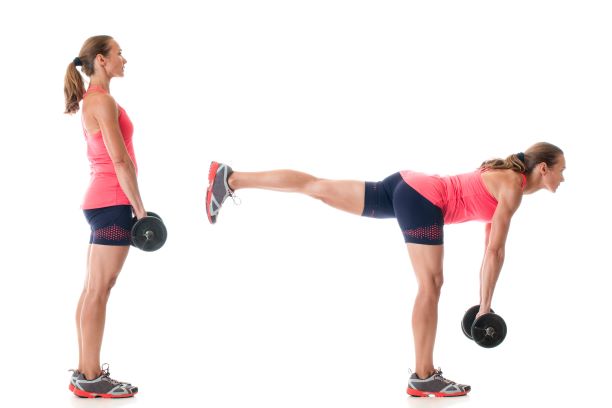The primary role of the gluteus medius is to stabilize and control movement of your pelvis during weight bearing activities. Efficient walking, climbing stairs, running, jumping, and throwing can not occur without your gluteus medius. All of these activities require at least a brief period of single leg support. The gluteus medius maintains your pelvis level and prevents the opposite side from dropping. Without adequate functioning of this muscle, your balance, strength, power, and performance will be compromised. Also, abnormal movement patterns occur due to inadequate gluteus medius function,and this predisposes you to injury.
This is the second post of a 3 part series on gluteus medius exercise (basic and advanced gluteus medius exercises). It is advantageous to progress exercises for the gluteus medius from non-weight bearing to standing positions. The exercises included in this article are 5 options but there are many others. Always perform these exercises in a slow and controlled manner maintaining appropriate body alignment. The emphasis should first be on proper technique before adding repetitions or resistance.
Band Hip Abduction
Band hip abduction is performed with an elastic band tied around your ankles standing in an upright position with your feet together. Your feet are then pulled slightly apart. Stand on one leg while keeping your pelvis level. Raise your other leg about 25° to the side while maintaining your trunk upright. The most common mistake is to lift too far and tip your body to the other side. It is also important to keep your toes pointing straight ahead throughout the exercise. Tension should be maintained on the band so your feet do not touch. Both your supporting and moving side gluteus medius are very active during this exercise but the standing leg receives the greater training effect.
Band Internal & External Rotation (IR/ER)
Band IR/ER is performed with an elastic band tied around your thighs (just above your knees). Stand in an upright position with your feet together. Once the band is in place, separate your feet to shoulder width or slightly wider. Keep your knees and hips flexed to 30°. Your hands are placed on your hips. Initiate the movement by slowly moving one knee inwards over a 2 second period. Maintain the position of your opposite knee. Then slowly pull your same knee outwards over a 2 second period. Perform 8 to 12 repetitions in a slow and controlled manner on one side before switching to the other leg.
Lateral Band Walk
The lateral band walk is performed with an elastic band tied around your ankles standing in an upright position with your feet together. During the exercise your knees and hips are flexed about 30°. Your hands are placed on your hips. Sidestepping is initiated by leading with one leg over a distance slightly wider than shoulder width. It is important to keep your toes pointing straight ahead and your knees over your toes throughout the exercise. Tension should be maintained on the band so your feet do not touch. Three slow steps are performed in one direction followed by 3 steps in the opposite direction. Each cycle constitutes 1 repetition. Typically, 6 to 8 repetitions are performed each set. To increase the challenge of this exercise, two bands can be used. The second band can be placed above your knees.
Dynamic Leg Swing
The dynamic leg swing begins by standing on one leg with your opposite knee flexed to 90 degrees. Initiate the movement by swinging your non-weight bearing leg (with the knee flexed). Move into hip flexion and extension at a rate of 1 second forward and one second backward. Move through a smooth range of hip motion and do not allow your trunk to move out of the upright position. Also, maintain the position of your weight bearing leg during the exercise. Perform the 8 to 10 repetitions on one leg before switching sides. The challenge of the exercise can be increased by holding a dumbbell or kettle bell in your hand on the side of the swinging leg.
1-Leg RDL
The single-leg Romanian dead lift begins by standing on one leg with the opposite hip and knee extended. Your weight bearing knee can be slightly bent throughout the exercise. Initiate the movement by slowly flexing at your hip, keeping your back straight. The non-weight bearing leg extends straight back behind your body. Both the descending and ascending parts of the exercise should be performed in a slow and controlled manner. Also, maintain control and position of the weight bearing leg during the exercise. Perform the 8 to 10 repetitions on one leg before switching sides. The challenge of the exercise can be increased by holding a dumbbell or kettle bell in the hand on the side of the swinging leg.
Gluteus Medius Exercises: Get Started Today
These 5 exercises can be used as a standalone program for improving gluteus medius activation and strength. However, all 5 exercises do not need to be performed. Choose 2-3 exercises to perform 3 days per week. These exercises are also ideal for athletes and exercise enthusiasts to incorporate into their warm-up routines. Specifically, try 2 or 3 of these exercises prior to performing compound lifts such as the squat or dead lift. Next week we’ll highlight some more advanced progressions to load the gluteus medius. If you have any questions, give your physical therapist a call. We are here to help.

